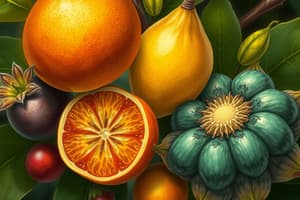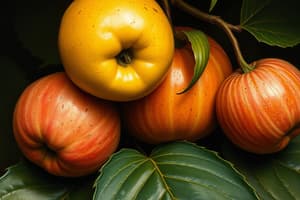Podcast
Questions and Answers
Match each description with the correct type of fruit:
Match each description with the correct type of fruit:
consists of an outer fleshy layer and an inner papery core = Pome consists of a small dry seed with one or two wing-like structures = Samara entire ovary is fleshy and juicy throughout = Berry consists of an outer fleshy layer and an inner woody layer = Drupe
The sperm and egg are a plant's reproductive cells, or _____
The sperm and egg are a plant's reproductive cells, or _____
gametes
All fruits that have spines use wind dispersal to spread their seeds.
All fruits that have spines use wind dispersal to spread their seeds.
False (B)
What type of seed dispersal is used by sandburs?
What type of seed dispersal is used by sandburs?
Which fruit forms from a single flower with several pistils?
Which fruit forms from a single flower with several pistils?
The sweet-tasting, watery liquid produced by the flowers of certain plants is called _____
The sweet-tasting, watery liquid produced by the flowers of certain plants is called _____
Which type of fruit consists of an outer fleshy layer and an inner woody layer?
Which type of fruit consists of an outer fleshy layer and an inner woody layer?
All fruits with spines rely solely on wind dispersal to spread their seeds.
All fruits with spines rely solely on wind dispersal to spread their seeds.
Match each plant reproductive structure with its description:
Match each plant reproductive structure with its description:
Which type of fruit is characterized by being entirely fleshy and juicy throughout?
Which type of fruit is characterized by being entirely fleshy and juicy throughout?
What term describes a fruit that has both a fleshy outer layer and a papery core?
What term describes a fruit that has both a fleshy outer layer and a papery core?
Explain the significance of nectar in plant reproduction.
Explain the significance of nectar in plant reproduction.
What are gametes in the context of plant reproduction?
What are gametes in the context of plant reproduction?
Identify one characteristic of aggregate fruits.
Identify one characteristic of aggregate fruits.
What mechanism does the sandbur use for seed dispersal?
What mechanism does the sandbur use for seed dispersal?
What distinguishes a pome from a drupe in terms of their structure?
What distinguishes a pome from a drupe in terms of their structure?
How do gametes function in the reproduction of plants?
How do gametes function in the reproduction of plants?
What is the role of nectar in plant reproduction?
What is the role of nectar in plant reproduction?
Describe the seed dispersal mechanism used by sandburs.
Describe the seed dispersal mechanism used by sandburs.
What defines an aggregate fruit, and how is it formed?
What defines an aggregate fruit, and how is it formed?
What is the function of the radicle in plant development?
What is the function of the radicle in plant development?
Flashcards are hidden until you start studying
Study Notes
Fruit Types
- Pome: Has an outer fleshy layer and an inner papery core (e.g., apples, pears).
- Samara: Contains a small dry seed adorned with one or two wing-like structures, aiding in wind dispersal.
- Berry: Characterized by a fleshy and juicy ovary throughout, includes fruits like tomatoes and grapes.
- Drupe: Features an outer fleshy layer and a hard inner woody layer, typical examples are cherries and peaches.
Plant Reproduction and Dispersal
- Gametes: The reproductive cells of a plant, namely sperm and egg.
- Animal Dispersal: Observed in the sandbur, where fruits with spines attach to animals or clothing, facilitating movement and germination in different locations.
- Aggregate Fruit: A type of fruit arising from a single flower that possesses multiple pistils, seen in fruits like raspberries and blackberries.
Additional Plant Processes
- Nectar: A sweet, watery liquid secreted by flower glands, attracts pollinators and aids in reproductive processes.
- Radicle: The embryonic part that develops into the root system, essential for nutrient uptake and anchorage of the plant.
Fruit Types
- Pome: Has an outer fleshy layer and an inner papery core (e.g., apples, pears).
- Samara: Contains a small dry seed adorned with one or two wing-like structures, aiding in wind dispersal.
- Berry: Characterized by a fleshy and juicy ovary throughout, includes fruits like tomatoes and grapes.
- Drupe: Features an outer fleshy layer and a hard inner woody layer, typical examples are cherries and peaches.
Plant Reproduction and Dispersal
- Gametes: The reproductive cells of a plant, namely sperm and egg.
- Animal Dispersal: Observed in the sandbur, where fruits with spines attach to animals or clothing, facilitating movement and germination in different locations.
- Aggregate Fruit: A type of fruit arising from a single flower that possesses multiple pistils, seen in fruits like raspberries and blackberries.
Additional Plant Processes
- Nectar: A sweet, watery liquid secreted by flower glands, attracts pollinators and aids in reproductive processes.
- Radicle: The embryonic part that develops into the root system, essential for nutrient uptake and anchorage of the plant.
Fruit Types and Descriptions
- Pome: A fruit type characterized by an outer fleshy layer surrounding a papery core.
- Samara: A type of fruit featuring a small dry seed equipped with one or two wing-like structures facilitating wind dispersal.
- Berry: Defined as a fruit where the entire ovary is fleshy and juicy throughout, lacking a hard stony layer.
- Drupe: This fruit has an outer fleshy layer along with a hard woody inner layer encasing the seed.
Key Biological Concepts
- Gametes: The reproductive cells in plants, including sperm and egg cells.
- Animal Dispersal: A seed dispersal mechanism utilized by plants like sandbur, where seeds attach to animals or clothing to travel to new locations.
- Aggregate Fruit: A type of fruit formed from a single flower that has multiple pistils, resulting in several small fruits clustered together.
- Nectar: A sweet and watery liquid produced by flower structures, attracting pollinators.
- Radicle: The embryonic part of a plant that develops into the root system, crucial for anchoring and nutrient absorption.
Fruit Types and Descriptions
- Pome: A fruit type characterized by an outer fleshy layer surrounding a papery core.
- Samara: A type of fruit featuring a small dry seed equipped with one or two wing-like structures facilitating wind dispersal.
- Berry: Defined as a fruit where the entire ovary is fleshy and juicy throughout, lacking a hard stony layer.
- Drupe: This fruit has an outer fleshy layer along with a hard woody inner layer encasing the seed.
Key Biological Concepts
- Gametes: The reproductive cells in plants, including sperm and egg cells.
- Animal Dispersal: A seed dispersal mechanism utilized by plants like sandbur, where seeds attach to animals or clothing to travel to new locations.
- Aggregate Fruit: A type of fruit formed from a single flower that has multiple pistils, resulting in several small fruits clustered together.
- Nectar: A sweet and watery liquid produced by flower structures, attracting pollinators.
- Radicle: The embryonic part of a plant that develops into the root system, crucial for anchoring and nutrient absorption.
Studying That Suits You
Use AI to generate personalized quizzes and flashcards to suit your learning preferences.




